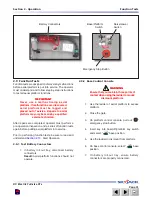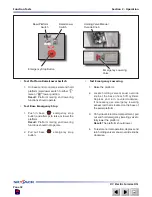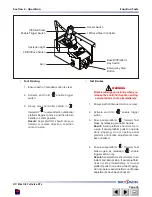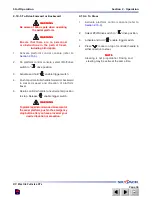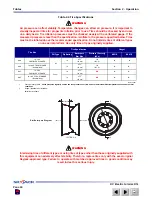
TM
Page 46
December 2007
DC Electric Full-size RTs
Winching and Towing Procedure
Section 2 - Operation
2.12 Winching and Towing Procedure
This section provides the operator with procedure about
winching and towing and on how to manually release
brakes.
wARNiNG
Ensure platform is fully lowered before
winching or towing. Sudden motion could
cause aerial platform to become unstable.
Death or serious injury could result.
wARNiNG
In emergency situations where aerial
platform functions are not available and
lowering is impeded by an obstacle,
utmost care must be taken to move aerial
platform far enough to clear obstacle. In
such cases, operation must be extremely
smooth with no sudden movements
and must not exceed a speed of 2”/sec
(50 mm/sec).
wARNiNG
When pushing, winching or towing, do
not exceed 2 mph (3.2 km/h).
wARNiNG
Do not push, winch or tow aerial platform
onto a slope, or brake the towing vehicle
rapidly. Do not pull aerial platform down
an incline towards a winch.
2.12-1 To Release the Brakes Manually
wARNiNG
Do not manually disengage brakes if the
aerial platform is on a slope.
2
1
Figure 2-19. Brake System
1.
Brake Hand Pump
2.
Brake Auto Reset Valve Plunger
wARNiNG
Brakes must be manually disengaged
before pushing, winching or towing.
1.
Ensure aerial platform is on level ground. Chock
or block wheels to prevent aerial platform from
rolling.
2.
Disconnect battery connectors.
3.
Locate the manifold in hydraulic/electrical
compartment.
4.
Push in brake auto valve plunger.
5.
Grasp brake hand pump and rapidly depress
until firm resistance is felt. The brake is now
released.
6.
Remove wheel chocks or blocks then push, winch
or tow aerial platform to desired location.
wARNiNG
Brakes must be reengaged immediately
after reaching desired location.
7.
Position aerial platform on a firm and level
surface.
8.
Chock or block wheels to prevent aerial platform
from rolling.
9.
Reengage brake by pulling out brake valve
plunger.

